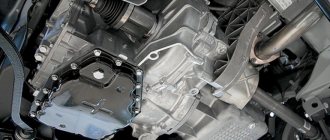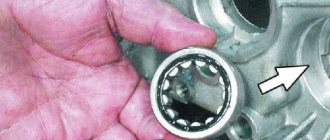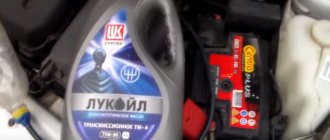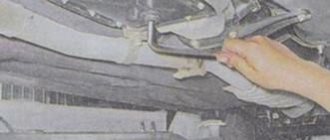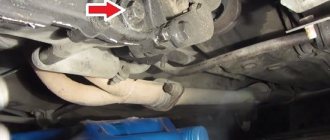If the transmission oil in the automatic transmission begins to foam, you should not ignore it. Most often, the driver encounters small air bubbles when he next determines the oil level in the automatic transmission using a dipstick. If the oil in the box foams, this indicates the appearance of malfunctions and increased wear of working parts and components inside the automatic transmission. Insufficient lubrication of internal components leads to an increase in the temperature in the automatic transmission, deteriorating the quality of gear shifting.
Causes of automatic transmission oil foaming
Overheating of the box is not the only danger resulting from oil foaming. This also threatens the breakdown of the electronic control unit with subsequent failure of the entire transmission. If the oil in the automatic transmission foams, the reasons should be looked for in the following:
- Low quality of filled lubricant.
- Excess ATP oil volume.
- Insufficient amount of working fluid.
- Penetration of air into the lubrication system of the box.
- The time interval between complete automatic transmission oil changes is too long.
- Driving too vigorously.
Why is oil leaking from the gearbox?
Having discovered the first signs of oil leakage from the gearbox, or between the engine and gearbox, you should quickly find out the defective location. You can see an oil puddle under the hood of your car or under the bottom, but for this it will be more convenient to drive the car onto an overpass. In any case, if the liquid drips, this flaw must be gotten rid of.
Sometimes it is very difficult for a driver, especially if he has been driving recently, to determine the very defective place. This is mainly due to the fact that the process of finding fluid leaks from the transmission or between the engine and the transmission can be complicated by a number of circumstances, as well as limited access to most weak points of the transmission. Based on practice, we can assume for what reasons liquid is leaking or dripping:
- unsuitability of seals;
- wear of the shafts, which are, in one way or another, connected to the sealing elements;
- non-standard play in the automatic transmission input shaft;
- the need to replace the sealing layer;
- loosening the bolts connecting the elements of the box;
- unsuitability of the seal.
Adding fluid to the automatic transmission
If you notice that the seals on your automatic transmission are really old but dry, then it is better to replace them immediately so that they do not become the next cause of leakage. If the leak problem lies in the seals, then they should also be replaced.
To replace the wheel drive shaft oil seals, you need to proceed in the following steps:
- First you need to drain all the oil from the box.
- Then you need to rinse the box with kerosene or diesel fuel so that the remains of the old liquid do not remain on the walls.
- Unscrew the wheel bearing nut and several bolts securing the ball joint.
- Remove the axle shaft.
- Remove the oil seal using an awl or a screwdriver.
Automatic transmission oil foaming due to improper mixing
Why does the gearbox oil foam? It often happens that during car maintenance, too economical car owners mix ATF fluids of different origins. When combining oils produced by different companies, as a result of a chemical reaction between special additives - additives, abundant foam can form. If the additives have lost their beneficial properties, the lubricating fluid will not perform its functions. During the further operation of the vehicle, the metal surfaces of working units and gearbox parts will wear out several times faster.
Troubleshooting
If the ATF level is below about:
- It is necessary to inspect the underbody of the car in search of leaks from the automatic transmission and carry out repairs if broken hoses, deformed parts, or worn gaskets are found;
- Add the same ATF that is filled into the box to the required level.
When the oil foams, its volume increases, so the level on the dipstick will be above the top notch. To make sure, when checking again, turn off the heated engine and wait until the liquid settles. Excess oil is drawn out using a technical syringe and a thin tube.
If foam in the gearbox oil occurs due to aging, overheating, or an unsuccessful mix of various fluids:
- Remove and wash the pan.
- Completely drain the unusable liquid.
- Replace filters.
- Clean the radiator.
- Fill with fresh fluid recommended by the manufacturer.
In the most advanced cases, it will be necessary to overhaul, diagnose and replace automatic transmission parts. In order not to bring the transmission to repair, you need to take into account the design features of both gasoline and diesel automatic transmissions during operation:
- sudden movements at the start and during braking overload the torque converter;
- when slipping for a long time or towing heavy trailers, the automatic machine overheats due to high loads;
- Automatic transmission needs regular maintenance.
How does an abnormal oil level affect the quality of lubrication?
If the volume is excessive, the transmission oil in the automatic transmission and variator can also foam.
This is especially true for automatic transmissions produced by automakers:
- Toyota;
- Volkswagen;
- Mercedes;
- BMW.
Automatic transmissions of these models are the most sensitive to lubricant overflows. For this reason, sealing gaskets, oil seals, valves, torque converter friction discs, etc. often fail here.
The role of atf fluid in the operation of the gearbox
Since many people understand all types of automated transmissions by automatic transmission, it is worth determining the fact that a torque converter automatic transmission differs from a variator. In the latter, the oil can also foam, which we will definitely look into.
Let's start with the most common type of automatic transmission. In a torque converter type box, the role of lubrication is one of the most important in the operation of the entire mechanism. In order not to go deeply into the operating principle of an automatic transmission, we will only consider the role of oil. The hydraulic automatic machine consists of three main parts:
- mechanical;
- hydraulic;
- electronic
The friction pack consists of driven and driven discs. It is the lubricant pressure that causes the discs to move from a state of free rotation in an oil environment into a single unit. Since the driven disk is rigidly connected to a specific planetary gear mechanism, the attachment of the driving disk drives the planetary gearbox. In this way, torque is transmitted from the motor to the drive shafts.
Why foam is synonymous with danger
Automatic transmission fluid is an intermediate link in the transmission of torque. It is oil pressure that closes the friction packs. Therefore, automatic transmission oil is often called a liquid, since in addition to its lubricating function, it also acts as a hydraulic press. A foaming composition causes a change in the density of the liquid.
Foamed oil, even with a working torque converter and valve body, will create less pressure on the friction packs. The consequence of this will be longer slippage of the discs, which leads to their accelerated wear. If the problem is left unattended, oil starvation will lead to critical wear. Prolonged slippage leads to overheating of the discs themselves and the lubricant. Burnt oil will begin to coke, clogging the hydraulic channels. Sticking of plungers and solenoids will lead to shocks and kicks when switching. Of course, dirty channels will further aggravate oil starvation.
Also, foamed emulsion has a lower heat capacity and heat transfer, which increases the risk of overheating. Now you understand that foam in ATF fluid is a really serious problem.
Why does a car need lubricant?
Remember that any car oil will darken with use. This is due to various reasons. First of all, you need to deal with the car oil. Today, the lubricant that is poured into a gasoline/diesel internal combustion engine is a liquid consisting of many components that performs various tasks in the power unit, such as:
- Formation of a lubricating film on contacting parts.
- Heatsink. When an internal combustion engine operates, its parts rub, therefore, the temperature increases. If there is no heat dissipation, the metal will begin to become wider. Because of this, the engine may jam.
- Washing parts to eliminate dirt and wear effects. Due to friction, small metal shavings appear. It is abrasive and the motor wears out quickly.
Gases entering the crankcase from the cylinder block contain soot. Do not allow it to settle on the parts.
Alkali neutralizes acids. If it is in the lubricant, foreign particles do not remain on the internal combustion engine parts. Due to the dissolution of soot and dirt in the car oil, it quickly darkens.
To get rid of a false alarm, you need to understand how oil works in the engine. In gasoline and diesel power units, lubricant is a universal product. It not only maintains the sliding of surfaces, but also cleans them of inevitable technical dirt. For this purpose, the lubricating mass contains various additives that are responsible for correcting the base number inherent in the product.
If the engine oil is dark, this means that the lye is doing the necessary work. The substance neutralizes acids, eliminates deposits of dirt and carbon deposits. Naturally, the lubricant quickly darkens during continuous cleaning of engine components. The constancy of the original color of the lubricating and cleansing mass, on the contrary, indicates its insufficient effectiveness.
Often the causes of dirt deposits in car components and, accordingly, their accelerated wear lie in the low content of alkaline additives. Conversely, quickly darkening oil in a gasoline or diesel engine indicates the sufficiency of the alkaline number and its cleaning ability. Proper lubrication will help avoid two main causes of disruption to the normal operation of the unit:
- Oil starvation due to the appearance of contamination zones that complicate the penetration of oil fluid.
- Violations of the temperature regime of the engine, as mud deposits prevent heat removal. Local overheating will result in destruction of the camshaft, rotation of the liners, and other malfunctions.
Why does engine oil foam?
If the engine oil foams, the reasons for this may be the following:
- condensation formation;
- the use of oil compositions that are incompatible with each other;
- depressurization of the engine cooling system.
- Condensate
Condensation may form on metal engine parts and flow into the oil. But these liquids cannot mix and will not dissolve into each other. When moisture and lubricant come into contact, the surface of the water particle is enveloped in small air bubbles, the lubricant turns into a kind of emulsion, and the driver notices that the oil in the engine is foaming.
Condensation occurs more often during certain seasons. For example, the oil mixture in the engine may foam during the winter season. After all, drivers often start driving in a cold car. A similar phenomenon can be observed in the off-season, especially if the car is not used for long trips. The fact is that moisture accumulates, and due to the fact that the engine does not run for long, it does not evaporate; it remains in the oil.
Variable speed drive
Most CVT gearboxes, like hydraulic automatic transmissions, contain a torque converter. Despite the fact that the operating principle of these gearboxes is radically different, the role of oil remains extremely important. This is evidenced even by the special classification to which CVT liquid belongs. The reasons for foaming of the variator oil include:
- incorrect oil level (both overfilling and underfilling);
- low-quality liquid, mixing oils with incompatible chemical composition.
Oil starvation leads to the “eating” of the belt, the formation of scuffs on the belt and the “mirror” of the cones, and slipping of the friction discs of the device that acts as a clutch in the variator. The loose fit of the belt to the shaft cones is characterized by shocks when starting to move.
After detecting foaming, first check the fluid level. Instructions for checking are included in every vehicle owner's manual.
Mixing liquids
When replacing technical fluids in a car, it is extremely important to remember that it is not advisable to mix different fluids. This is often the sin of car owners who want to save money. Mixing two oils from different brands or brands may cause foaming. The formation of foam in this case is the result of a chemical reaction that can occur between the various components of the oils. In this case, the oil mixture loses its protective properties. As a result, the use of such oil leads to increased wear of the transmission.
In this situation, the only and obvious solution is to change the oil. The replacement must be done by flushing the gearbox with a specialized fluid, which will remove all remnants of the old process fluid. It is best to leave the car in the hands of specialists to avoid any breakdowns. However, if you have the appropriate skills, you can wash the gearbox yourself. In the latter case, it is worth remembering that flushing must be done until there are no traces of used oil left in the flushing liquid. If the design includes a filter, then before washing it must be removed, and before adding new liquid, a new filter must be installed.
Features of automatic maintenance
An automatic is a transmission in which gears change automatically. It is very convenient and makes driving comfortable. However, the machine has some disadvantages:
- The design is more complex than that of a manual transmission, which is why automatic transmissions are more demanding in maintenance and repair.
- Increased fuel costs. Automatic cars consume more fuel than manual cars.
- Slight decrease in dynamic performance. This applies to cars with low power. They begin to accelerate more slowly.
Automatic transmission diagram
To avoid problems with using your car, you need to choose transmission lubricant wisely and replace it. The oil must meet all requirements of the transmission manufacturer. They are usually prescribed in the operating manual. It is possible to change the oil fluid yourself, but it is advisable to entrust this procedure to professionals. Errors during transmission maintenance lead to problems, for example, the lubricant may foam.
https://youtube.com/watch?v=CGOvUGBjhZw%3F
Timely repairs
Immediately after detecting foam and identifying the causes of foaming in the gearbox oil, all problems must be eliminated as quickly as possible. If nothing is done, then after 10 thousand kilometers the cost of repairs can increase many times over, since a regular oil change will not restore worn-out components. The first thing you need to pay attention to is the fluid level and its compliance with the recommendations. Changing the fluid will help avoid re-foaming, for which your car will only thank you. If you were unable to identify the cause on your own, you should not postpone your visit to a specialist for too long. Have you encountered this problem?
Neglect of maintenance
As you know, any technical fluid cannot retain its properties forever, so its timely replacement is always required. If you refer to the vehicle manual, the transmission fluid replacement intervals are naturally indicated with a certain reserve. This was done in order to extend the service life. However, if the specified intervals are significantly exceeded, foam may appear in the gearbox. Timely replacement will eliminate foaming and undesirable consequences. The replacement interval depends on the type of gearbox and the type of oil. We can provide the following expert recommendations:
- Synthetic in manual transmission - at least 70 thousand km.
- Synthetic in automatic transmission - at least 50 thousand km.
- Synthetic in the variator - at least 30 thousand km.
- Mineral in manual transmission - every 30 thousand km.
- Mineral in automatic transmission - every 20-30 thousand km.
Read more: How to find out someone else’s login in Odnoklassniki
The above intervals may vary depending on operating conditions. The frequency of fluid changes may increase when driving off-road or sitting for a long time in traffic jams. Under these conditions, the loads increase slightly, which can lead to a reduction in the replacement interval by up to 1.5 times. For more accurate information, please refer to the vehicle manual.

